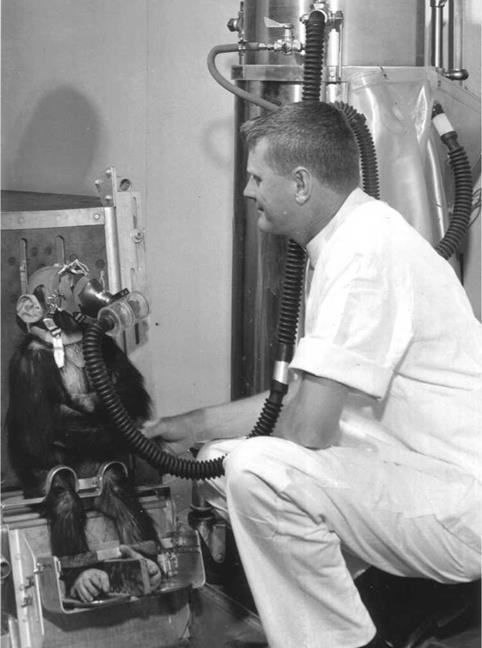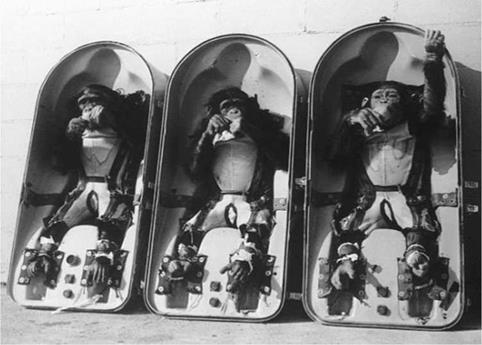OUT OF AFRICA
Ham was a Pan troglodyte chimpanzee, said (through dental analysis) to have been born around July 1957, and was one of several animals captured by trappers at a very young age in the dense tropical rainforests and savannah of the French Cameroons in Equatorial Africa. According to an article in the April 1962 issue of The Airman, three members of the U. S. Air Force had flown to the French Cameroons to pick up a number of animals.
|
M/Sgt. Ed Dittmer assisted Ham in his flight training. (Photo courtesy of Edward C. Dittmer) |
As one of these men recalled, “When the chimps were captured, they were very small and usually ranged in age from 10 to 18 months. The natives tie them with strips of bamboo when they capture them, and make no particular arrangements for holding or feeding the young animals. When the vendor, who sells them to us, finally obtains them, they are quite heavily parasitized and malnourished.” [2]
Following their transportation to the United States in 1959, Ham and the other young chimpanzees were temporarily housed at the now-defunct Rare Bird Farm in Miami, Florida. Eventually this latest batch of chimps was delivered to Holloman AFB’s Air Development Center in New Mexico to join an established colony, where they were assigned identifying subject numbers and unofficial training names such as Caledonia, Chu, Duane, Elvis, George, Jim, Little Jim, Minnie, Paleface, Pattie, Roscoe, and Tiger.
Dittmer was one of several aeromedical technicians assisting in bioastronautics research for the Air Force Systems Command at Holloman AFB, reporting directly to Capt. David Simons at the Space Biology Branch of the 6571st Aero Medical Research Laboratory.
Another member of the Holloman research team was Dr. James P. Henry, who had earlier been involved in studies of blood action under heavy gravity weights and had conducted pioneering work in developing high-altitude protective clothing. Dr. Henry
|
Chimpanzee space candidates Duane, Jim, and Chu enjoy a snack while training to endure prolonged periods strapped into a capsule couch at Holloman AFB. (Photo: USAF) |
was appointed as an Air Force representative to a NASA committee charged with defining and setting in motion plans and procedures for animal flights within Project Mercury. He was assigned the role of coordinator for these flights under Lt. Col. Stanley White, a physician and the leader of the Mercury medical team, and he became part of NASA’s Space Task Group at Langley Field, Virginia.
Henry’s specific responsibilities included the establishment of an animal flight test protocol, developing the operational flight plans, and overseeing the design and manufacture of the flight hardware. He would also monitor the chimpanzee regime at Holloman, where personnel from the research laboratory had been training animals for space flight since July 1959. Initially, the plan was to train and test ten suitable chimpanzees from the colony. As with earlier programs, they began by incrementally conditioning the animals to accept the restraint conditions to which they would be subjected in a spacecraft [3].
Ed Dittmer became involved in working with the chimpanzee colony under the Space Biology Branch at Holloman, where he was the officer in charge. “Back then we got these small chimps from Africa – they were about a year old – and we started a training project,” he recalled. “Of course a lot of things were classified back then, so
|
The test subjects had to learn to sit in metal chairs and move levers. Ham is seated at the rear; the chimp at front is Enos, who would fly an orbital mission in November 1961. (Photo: NASA) |
we had no real idea what we were training these chimps for, but we were teaching them to sit up and work in centrifuges, so it was quite evident that we were training them for use in missiles.
“We started out by teaching them to sit in these little metal chairs, set about four or five feet apart so that they couldn’t play with each other. We’d dress them in little nylon web jackets which went over their chests, and then fasten them to their chair. We’d keep them in the chairs for about five minutes or so and feed them apples and other fruit, and we’d progressively put them in their seats for longer periods each day. Eventually they’d just sit there all day and play quite happily.” [4]
Each of the chimpanzees was kitted out with one of these nylon “spacesuits,” and soon came to accept wearing them. During lengthy training exercises, a diaper would also be worn beneath the nylon suit.













